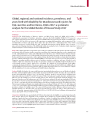Quando criança, na década de 30 passei parte de meus anos numa vila de colonização Alemã no interior (Agudo, então distrito de Cachoeira) onde havia casos da doença e, de vez enquando, alguém desaparecia, e diziam que havia sido levado para o Leprosário. Quando eu ia para a Escola, passava frente a uma casa que ficava um tanto retirada da estrada (passávamos de longe por que diziam ser de família de leprosos...) Até hoje não sei bem, se era doença ou se era um prostíbulo, do qual não deveríamos nos aproximar...
Com relação à Talidomida, foi da época da segunda gestação da Dra. Valderês, e era prescrição para controlar hiperemese gravídica...
50 years ago, a drug that crippled a generation found new life as a leprosy treatment
Excerpt from the July 19, 1969 issue of Science News

SECOND CHANCE Thalidomide, a sedative prescribed to pregnant women in the 1950s and early 1960s, was banned for causing severe birth defects such as malformed limbs. The drug found new life, though, as a leprosy treatment, and is still used today.
STEPHENCDICKSON/WIKIMEDIA COMMMONS (CC BY-SA 4.0)
Citations

Update
The FDA approved thalidomide for leprous skin lesions in limited cases in 1975. Related drugs were approved after 2005 also to help control the immune system and calm inflammation. These drugs also treat psoriasis, arthritis and the blood cancer multiple myeloma. Birth defects remain a risk, so use of thalidomide and its analogs is controlled in the United States. But lax oversight elsewhere means thalidomide is still misused. In Brazil, nearly 200 children born from 2005 to 2010 may have been disabled by the drug, a 2015 study found. The World Health Organization discourages thalidomide use for leprosy.
SN Staff. Leprosy: Thalidomide helps severe cases. Science News. Vol. 96, July 19, 1969, p. 50.
F. Sales Luiz Vianna et al. Pharmacoepidemiology and thalidomide embryopathy surveillance in Brazil. Reproductive Toxicology. Published June 2015. doi: 10.1016/j.reprotox.2015.03.007.
F. Sales Luiz Vianna et al. Pharmacoepidemiology and thalidomide embryopathy surveillance in Brazil. Reproductive Toxicology. Published June 2015. doi: 10.1016/j.reprotox.2015.03.007.
Further Reading
N. Seppa. Thalidomide treats Crohn’s disease. Science News. Vol. 185, January 11, 2014, p. 9.
SN Staff. Science Past from the issue of July, 1962. Science News. Vol. 182, July 14, 2012, p. 4.
N. Seppa. Old and new drugs may fight multiple myeloma. Science News. Vol. 158, December 16, 2000, p. 399.
SN Staff. Science Past from the issue of July, 1962. Science News. Vol. 182, July 14, 2012, p. 4.
N. Seppa. Old and new drugs may fight multiple myeloma. Science News. Vol. 158, December 16, 2000, p. 399.






 You can like LibraryThing on
You can like LibraryThing on 






![[object Object]](https://c5.rgstatic.net/m/4671872220764/images/template/default/profile/profile_default_m.jpg)

![[object Object]](https://i1.rgstatic.net/ii/profile.image/283568224915456-1444619341051_Q64/Rafael_Lozano6.jpg)
![[object Object]](https://i1.rgstatic.net/ii/profile.image/272669325131801-1442020842034_Q64/Nancy_Fullman.jpg)


![[object Object]](https://i1.rgstatic.net/ii/profile.image/702579537362944-1544519423006_Q64/Belete_Biadgo.jpg)
![[object Object]](https://i1.rgstatic.net/ii/profile.image/272141258063877-1441894940469_Q64/Stefan_Lorkowski.jpg)

![[object Object]](https://i1.rgstatic.net/ii/profile.image/514843107131392-1499759570917_Q64/Kalkidan_Abate.jpg)